We reached the busy checkpoint into Jerusalem at 1:15. As an
indication of the small size of Israel, our actual driving time from Magdala
in Galilee to Jerusalem was only about two and a half hours. Soon after
entering the city, our bus stopped at an overlook with a great view of the city, including the
the Old City and the golden Dome of the Rock. The professional photographer
traveling with us took a group picture there.
We then rode around the outside of
the old walled city. (We later learned that,
because of the layout of the roads, traffic
often had to go clockwise almost all the way
around the walls to get to a point on the
eastern side that was much closer, as the crow
flies, in the opposite direction.)
Over the centuries, the city walls have been
destroyed, rebuilt or moved many times. The area now within the walls was not even part
Jerusalem in King David’s time. When he captured the city in 1004 B.C., he walled in the Eastern
Hill, a small spur of land southeast and outside of the present walls. The city walls were first
expanded to the much larger Western Hill under King Hezekiah (c.700 B.C.). The present wall
was built by Ottoman Sultan Suleiman in 1538.
At 2:00 the bus let us off a short block from Lions’ Gate on the northeast side of the wall. That
block went up at a very steep angle. Pastor Keller flagged down a taxi and had it carry five
people, including us, up to the Gate. That is just one example of his solicitude.

Lions'
Gate |

St. Anne's Church |
After a short briefing by Shanee, our group entered the Old
City through the Lions’ Gate. Just inside we came to St. Anne’s Church (built by the Crusaders in 1140
on the site of a 450 A.D. church, and twice restored since then). It is the best-preserved Crusader
church in Jerusalem. It marks the traditional site of the home of Jesus' maternal grandparents,
Joachim and Anne, and the
birthplace of his mother, Mary. Next to the church was a large excavation of the Pools of
Bethesda, where Jesus healed a sick man.
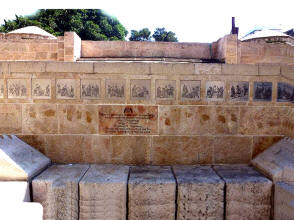
The
Via Delorosa begins |
From there we walked a short distance to the beginning of the Via Dolorosa, the traditional path
that Jesus walked from Antonia Prison to his crucifixion. On the wall there, the
14 traditional stations are
depicted. Each of the stations along the
route is marked by a large black disk with a Roman numeral on it, and most of them have small
churches or other religious buildings as well. But sometimes the disk was more confusing than
helpful, starting at the very first station.
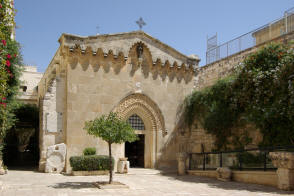
1. & 2. Church of the Flagellation |
The first disk was on the wall of a school that had been built on the site of the Antonia Fortress where Jesus
is said to have been imprisoned, tried and sentenced. But early on the Via
Dolorosa we came to the Franciscan Monastery of
the Flagellation (which includes the Church of
the Condemnation and Imposition of the Cross).
That covered stations 1 (Jesus is condemned) and
2 (Jesus receives his cross), but it has no
disk.

3. Jesus falls the first time |
Station 3 (Jesus falls the first time) was marked by a Polish chapel. Station 4 (Jesus meets his
mother) had an Armenian Catholic chapel. Station 5 (Simon of Cyrene carries the Cross) had a
Franciscan oratory that we visited. The old paving stones on the lower level were said to date to
Jesus’ time and “may have been” the very stones he walked on his way to Golgotha.
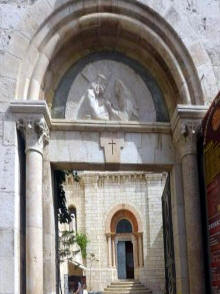
4. Jesus meets Mary |
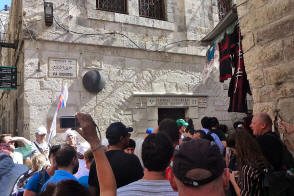
5. Simon carries the cross |
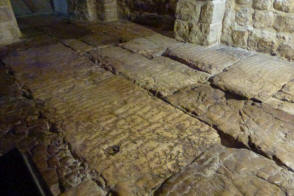
1st Century pavement |
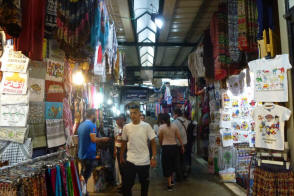
Passing thru a busy
arcade |
The area through which the Via Dolorosa ran included
many commercial areas,often in covered arcades. Between that and the
crowds, our group of 33 had been pretty much spread out over the course of
out walk. We never
saw more than a few of the others. Periodically, Shanee would appear in our path, waiving us on.

13. Jesus is taken down |
Station 13 (Jesus is taken down from the cross) was back
on the ground floor. It consisted of a decorated rectangular marble slab on
the floor where a body could be laid out to be prepared for burial. The wall
behind it was a moasic showing the body being laid out.
|
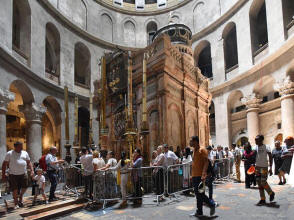 14 Jesus is placed in the tomb
14 Jesus is placed in the tomb
|
Finally, we proceeded to Station 14 (Jesus is placed in the
tomb), located in a massive circular hall (the Rotunda) in the very center
of the Church. The actual stone cut tomb is in a small cave well below the level of the Church floor, but it is covered by a
towering ornate structure (the Edicule). The line of people waiting to enter the Edicule
wrapped entirely around it. We did not have time to wait, so we did not go in. (Years earlier, we
had seen a replica of the tomb at the Franciscan Monastery of the Holy Land in
America in Washington, D.C.) so we knew what it looked like.

Passing thru the bazaar |
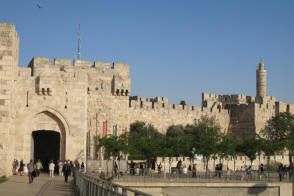
Jaffa Gate |
Leaving the Church of the Holy Sepulcher at about 4:20, we wound our way through the narrow
lanes of the bazaar to the Jaffa Gate. We found our bus and got to the Dan Panorama Hotel at
5:00, completely exhausted. It had been a very busy day.
[Now having described our exploration of the traditional Via Dolorosa, it is probably an
appropriate time to acknowledge that tradition has it wrong. The traditional route is based on the
assumption that Jesus was tried, and began his walk to Golgotha, at Antonia Prison in northeast
Jerusalem near the Lions’ Gate. However, in recent decades, it has been determined that Antonia
Prison was much smaller than originally believed and unsuitable to have accommodated either Pontius Pilot’s
retinue or his trial of Jesus. Since Pilate’s home and place of business was in Caesarea, the capital,
he stayed at Herod’s Palace and conducted all of his official business there
when he was in
Jerusalem. So Herod’s Palace is where Jesus would have been taken when he appeared before
Pilate. The ruins of Herod’s Palace have been located in the eastern part of the city near the Jaffa
gate, completely on the opposite side of the city from Antonina Prison. This makes it unlikely that
Jesus carried his cross along any part of the Via Dolorosa. Yet, our day’s walk did take us along
at least some of Jesus’ route, but that was as we left the Church of the Holy Sepulcher and
walked to the Jaffa Gate.]
We had a buffet dinner with the group at 6:45. A 10:40 tour of Hezehiah’s Tunnel had been
scheduled but was cancelled due to general fatigue. (These tours are by appointment only to avoid
overcrowding the narrow tunnels.) After dinner we went to our room and unpacked for our five
day stay at the Dan Panorama Hotel.